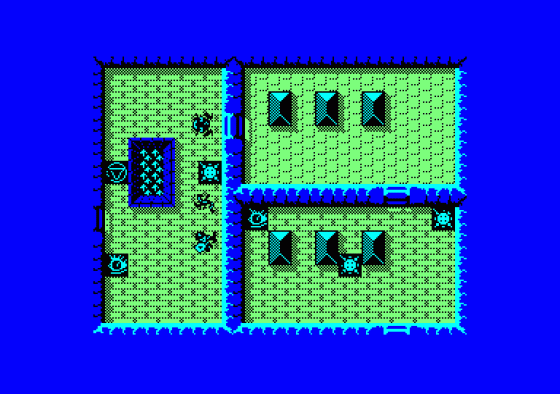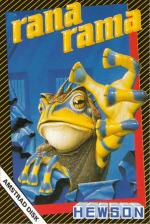
Amstrad Action
 1st June 1987
1st June 1987
Categories: Review: Software
Author: CB
Publisher: Hewson Consultants
Machine: Amstrad CPC464
Published in Amstrad Action #21
Mastergame
Ranarama
Steve Turner is a real stalwart of the games industry. His first game on the Amstrad was Dragontorc, a Rave in Amstrad Action issue 2. Although he's been more active on other computer formats, this new release exhibits his experience and imagination for games to the full. It's most conveniently described as a Gauntlet derivative that takes the format to new heights of gameplay and originality.
The hero is one Mervyn, a sorceror's apprentice who, while trying to improve his looks, has turned himself into a frog. You control the unfortunate amphibian and have to hop him through the dungeons of a castle, trying to turn him back into his old, ugly self. The dungeons have eight levels, each populated by all manner of nasty creatures and a smattering of wizards and necromancers.
The object of the game is to destroy all the warlocks on each level by taking them on in ritual combat. More of that later. The dungeons are made up of rooms and corridors, which occupy only small areas of the display. You're placed at random in a room on the first level; from there on it's a real mystery tour. You view the dungeons from overhead and initially you can only see the start room. As you move through the doorways, other rooms miraculously appear on the display, revealing their contents.

You can see only the creatures in the room you're in. Those in adjacent rooms become visible only when you go through the door. This element of exploration and the unexpected adds a lot to the enjoyment of the game. You might go straight past a crucial room without knowing it, or run headlong into a hornet's nest of danger.
When you find a warlock, you just have to collide with him and ritual combat ensues. It takes the form of a puzzle that has to be solved against the clock. The letters of the word Ranarama are scrambled and you have to get them back into place before the time runs out. This usually isn't too difficult, but trying to think fast and cope with a short deadline puts you under a lot of pressure. Success in combat results in several runes being scattered about the room. Collect these up before they disappear; they are extremely important to prolonging survival.
Once you've destroyed all the wizards on a level, the lights go out. In the inky darkness of the dungeons, you have to find the exit - could be a big problem for green-screeners.

The monsters come in a wide variety; living, dead and magical. They have varying strengths. All inflict power loss when they touch you. Some are created by generators in the rooms, which can also be destroyed. Others just wander around popping their heads 'round the door to see if they fancy a bit of battle with you. You can shoot most of them - frog-gob, I suppose.
Most rooms contain symbols on the floor called Glyphs. They come in four types: glyphs of seeing, power, travel and sorcery. The seeing glyph shows you a map of all the rooms you've visited on that level and revealing all exits as well. Power will kill any living creatures in the room with you. Travel operates a lift between levels. There are three lifts on every level, each one connecting to a different level.
The sorcery glyph is where you can use the runes you've collected. It allows you to cast different spells if you have the runes to do it. There are dozens of different spells, mostly of the same nature but with different power requirements and effects.

Creatures, moving and casting spells costs you power. When you're low, froggy starts to flicker and makes a squeaking noise - you're about to croak. You need to find an energy crystal quickly. And, since they're fairly random, that could be a problem. You effectively get two lives. The first is a power spell, and when that runs out you're mortal until you cast another one.
By now, people are probably starting to moan about the number of Gauntlet derivatives on the market. Doubtless Ranarama will take some flak on that front, but I think it's unjustified because the format is a wide one with plenty of room for development - which is exactly what Steve Turner has done. The revealing rooms, warlock combat and casting spells with runes makes this a much more absorbing game and less of a shoot-'em-up. It's a game that's very hard to stop playing. You can hang on to life, recasting power spells and exploring gradually further, but it's never easy.
First Day Target Score
Clear first level.
Second Opinion

Superb is the only word to describe Ranarama. Shoot-'em-up. hop-along, cast-a-spell and turn-me-back-to-a-prince are elements of this magical game. There are interesting musical tunes and a marvelous "show-what's-in-the-room-when-you-enter-it" feature. Although a Gauntlet clone, it is a worthy contender for the number-one spot. I only wish I could get to level eight.
Green Screen View
Some features very tough to spot when the lights go out.
Verdict
Graphics 88%
P. Detailed characters and animation.
P. Variety of dungeon designs.

Sonics 74%
P. Nice musical ditties and sound-effects.
Grab Factor 93%
P. The room-discovery element really grabs you.
P. Lots of variety of spells, opponents etc.
N. Gauntlet derivation takes some of the shine off.
Staying Power 90%
P. Eight levels get very tough.
N. The variety of opponents, rooms and spells continues throughout.
Overall 91%
P. Despite derivation, it's highly original.
Other Reviews Of Ranarama For The Amstrad CPC464
Ranarama (Hewson)
A review
Ranarama (Hewson Consultants)
A review
















